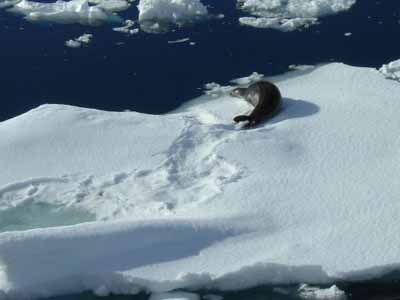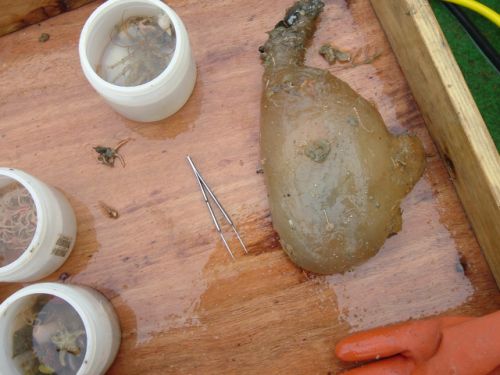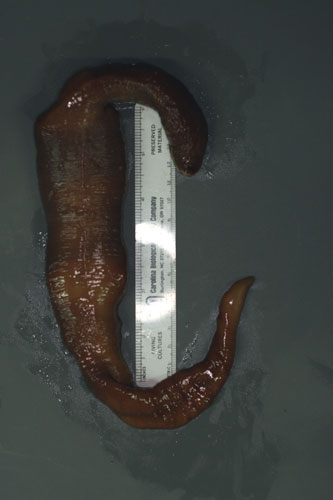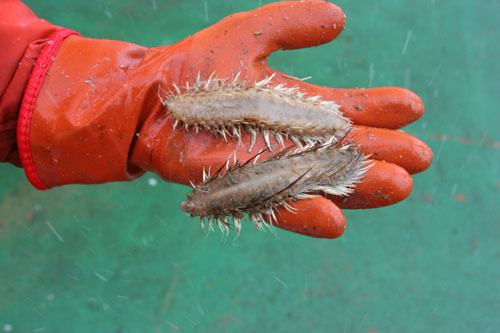[Wind: SW 1-2kn / Air Temp: -0.2C / Wind Chill: -0.2C /Depth: 460m / Seas 0-1ft] Station #83
| • Home |
| • Questions |
| • Participants |
| • Background Information |

| 1 | 2 | 3 | 4 | 5 | 6 | |
| 7 | 8 | 9 | 10 | 11 | 12 | 13 |
| 14 | 15 | 16 | 17 | 18 | 19 | 20 |
| 21 | 22 | 23 | 24 | 25 | 26 | 27 |
| 28 | 29 | 30 |
| 1 | 2 | 3 | 4 | |||
| 5 | 6 | 7 | 8 | 9 | 10 | 11 |
| 12 | 13 | 14 | 15 | 16 | 17 | 18 |
| 19 | 20 | 21 | 22 | 23 | 24 | 25 |
| 26 | 27 | 28 | 29 | 30 | 31 |
and with that rating, tells how much or what size ice the LMG can navigate in (“we are required to maintain forward headway of two knots in the first year ice or ice that is up to 1 meter thick”). When up in the Bridge and asking the Mate at the helm, however, “James, how do you know when you’re getting into the bigger ice - by radar or advance satellite reports?” “No,” he replies, “you know when the ship stops.” Good answer.
The ship speed is kept to ½ (usually around 5 knots) so that if the ship does stop in the ice, it has full speed power to pull it back out. Sensible. We’ve only had to do that once on my watch.
When pushing through the ice floe – which as much as I’ve seen is in segments and moves away from the hull easily - you can hear it scraping on the hull, especially in the mess hall. It sounds just like when your dad is parking the SUV too close to a snowbank, and it scrapes up against the doors. Only, constantly. From out on the deck, it’s beautiful to stand right up on the bow (there are platforms there, just for that!) and look down to see the bow of the ship pushing into a large, flat, pristine piece of floe (they’re usually 30-40 feet across), and slowly crack it to pieces, those pieces go off and push into other pieces, which bang up against the ones next to them, etc.
Once in a while we ‘disturb’ a seal, but they seem to be reticent to move most of the time, and will just roll over once or twice. Los penguinos are a bit different. They get up from their muddy iceberg and paddle off with their wings flailing! (Why do they always remind me of a toddler needing a diaper change? It must be that low Center of Gravity thing.) If you look carefully at the floe, you can see tracks on many of them. It’s easy to tell the seal tracks from the penguins’, as the seal’s looks like a toboggan trail where you’ve pushed along with mittened hands, and the penguin’s looks like a zipper, or a scar with lots of stitches. [See Image 1]
A word now about the scale of things here in the Antarctic. “Huge” just doesn’t do the trick. Gargantuan is better. For instance, from the Bridge and looking toward one of the continent’s peninsulas, I speculated it must be a mile from where we were. James said that, no, indeed it was at least 3 miles to shore. (For those of you in Woods Hole, that’s from Falmouth to Martha’s Vineyard. It just didn’t look that far to me!) The perspective is so different, if you’re not used to it. All this brings me to the topic of Gigantism. Dr. Ken Halanych writes a bit about this below:
During our cruise one major activity has been collecting invertebrate animals that live on the bottom of the waters of the Southern Ocean. In the first 20 bottom samples taken, we discovered that the benthic (bottom-dwelling) community can vary greatly from place to place, or at different depths. We typically find many brittle stars, soft corals, and sponges. These are mixed in with many seastars, isopods (pill-bugs), snails, and other animals. The Antarctic region is well known for gigantism. That is, some species are much larger in the Antarctic than their closely-related counterparts in warmer water. Pycnogonids, or sea spiders (see December 6th journal photo), are one such example. Typically a couple of centimeters (1 inch) or less in size, these animals grow up to 25 times that size in the Antarctic. We also recently found a sea squirt that was bigger than a football [See Image 2]!! The name “sea squirt” refers to the ability of species of tunicata to squirt water when squeezed. You can image the ohhhs when we found a slimy ribbon worm, typically 0.5-1 cm (less than ½ inch) thick, but here, as big as a black snake [See Image 3]. Image 4 shows a pair of polychaetes or “sea mice” that are usually up to only two inches long. [See Image 4] Scientists are not certain why so many animals get so big in the Antarctic. It may be the high seasonal availability of nutrients or the up-welling of nutrients from deeper waters. However, one other habitat that often exhibits gigantism is the deep sea, and the most obvious common factor that the both habitats share is cold water…very cold water.
We had a gorgeous, clear night heading southeast past Palmer Station on Anders Island, and then northeast to Bismarck Strait toward Gerlache Strait [pronounced Ger-lahsh]. Our destination-of-choice for tomorrow is Paradise Bay for some plankton and benthic work. Our ‘day off’ at Palmer Station will be on Thursday.

Photo3

Photo4

At that point, we start to pack up the labs and specimens. The Journal will continue while we cross Drake Passage, but if you have any questions about the trip in general, the science, or life on board the ship, please email them to us by Tuesday noon, 12/21. We will be shutting down most operations that evening, arriving in Punta Arenas the following morning.
Dinner Menu (shipboard, 12/14): | |
Pot roast, |